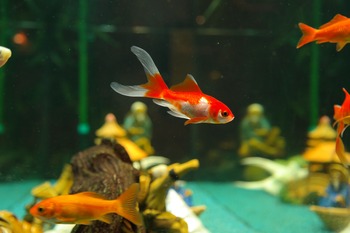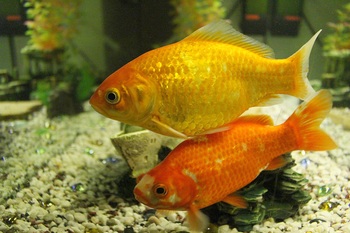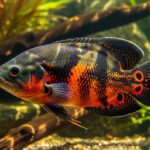Goldfish are often seen as simple, beginner-friendly pets — and while they’re certainly hardy, there’s more to them than meets the eye. One of the most common misconceptions is that goldfish only live for a couple of years, especially when kept in bowls. In reality, with the right care and environment, goldfish can live for decades.
So, how long can a goldfish live? And what can you do to help them thrive for as long as possible? Let’s take a closer look.
The Average Lifespan of Goldfish
On average, goldfish live between 10 to 15 years when kept in a well-maintained home aquarium or pond. However, this range can vary widely depending on several key factors like tank size, water quality, diet, and stress levels.
Some well-cared-for goldfish have been documented to live into their 20s or even 30s, and in rare, exceptional cases, over 40 years. That’s a big leap from the “2-3 years in a bowl” myth that many people still believe.
The Short Bowl Life: Why It Doesn’t Work
Goldfish are often sold in pet stores alongside small plastic bowls — which might seem convenient but are far from ideal. In fact, keeping goldfish in a bowl is one of the main reasons they die young.
Bowls are typically too small to accommodate the biological needs of goldfish. They:
- Lack proper filtration, leading to quick buildup of toxic waste.
- Offer limited swimming space, causing stress and stunted growth.
- Don’t allow for stable water parameters, which weakens the immune system.
The truth is, goldfish aren’t short-lived animals — they’re often short-kept due to poor care environments.

Key Factors That Influence Goldfish Longevity
If you’re aiming to help your goldfish live a long and healthy life, you’ll need to focus on a few core areas of their care.
1. Tank Size Matters
Goldfish may start small, but they can grow quite large — some reaching 8 to 12 inches in length. To accommodate their size and reduce stress, a minimum tank size of 20 gallons is recommended for one goldfish. For each additional goldfish, add at least another 10 gallons.
Larger tanks help in two major ways:
- They provide ample space for swimming, which reduces stress.
- They allow for more stable water conditions, which are crucial for long-term health.
Ponds are even better for common goldfish varieties, especially if you’re aiming for maximum lifespan.
2. Water Quality and Filtration
Water quality is perhaps the most critical factor in goldfish care. Poor water conditions can lead to disease, organ failure, and early death.
To maintain healthy water:
- Use a high-quality filtration system.
- Test for ammonia, nitrites, nitrates, and pH levels
- Perform regular partial water changes — about 25–30% weekly.
- Keep the water temperature stable — typically 65°F to 75°F for common goldfish.
Goldfish produce a lot of waste, and without proper filtration and maintenance, harmful toxins can quickly build up, making the water unsafe.
3. A Balanced, Varied Diet
A healthy diet is just as important for goldfish as it is for any other pet. A well-fed goldfish is more likely to live a long and vibrant life.
Here’s what to include:
- High-quality goldfish pellets or flakes as a staple.
- Occasional treats like brine shrimp, bloodworms, or daphnia (live or frozen).
- Fresh vegetables such as blanched peas, zucchini, or spinach to aid digestion.
Avoid overfeeding — uneaten food can rot and degrade water quality. Feed only what your goldfish can consume in about 2 minutes, 1–2 times per day.
4. Reducing Stress
Stress is a silent killer in goldfish. Chronic stress weakens the immune system, making them more vulnerable to diseases like ich, fin rot, and swim bladder issues.
Common stressors include:
- Overcrowding
- Sudden changes in water temperature
- Aggressive tank mates
- Poor water quality
- Inadequate hiding places
To create a stress-free environment:
- Maintain stable conditions.
- Use proper tank decor and plants to mimic natural surroundings.
- Avoid tapping on the glass or constantly disturbing them.
Fancy Goldfish vs. Common Goldfish: Does Breed Matter?
Yes, it does — to an extent.
Common goldfish, such as comets and shubunkins, tend to be hardier and longer-lived than their fancy counterparts. These simpler varieties are better suited to outdoor ponds and large tanks and can often reach 20+ years with great care.
Fancy goldfish, including orandas, fantails, and black moors, are bred for their ornamental features like rounded bodies and flowing fins. While beautiful, these traits come with trade-offs — fancy breeds are more prone to health issues, such as:
- Swim bladder problems
- Vision difficulties
- Sensitivity to temperature changes
As a result, fancy goldfish typically have slightly shorter lifespans, averaging around 8–12 years, although many still live much longer with proper care.
Real-Life Examples: Goldfish That Lived Decades
Believe it or not, some goldfish have lived impressively long lives. Here are a few record-holders:
- Tish, a goldfish from the UK, lived to the age of 43, earning a Guinness World Record before passing in 1999.
- Goldie, another British goldfish, was believed to be around 45 years old before its death.
- Many goldfish kept in outdoor ponds — especially in stable, low-stress environments — have been known to live 30 years or more.
These examples show that goldfish can be long-lived companions, sometimes lasting longer than cats or dogs!

Tips to Extend Your Goldfish’s Lifespan
If your goal is to help your goldfish reach a ripe old age, here are some key takeaways:
- Invest in a proper-sized tank or pond — at least 20 gallons for one goldfish.
- Use strong filtration and perform regular water changes to keep the environment clean.
- Feed a varied, balanced diet and avoid overfeeding.
- Keep stress levels low by maintaining stable conditions and avoiding overcrowding.
- Learn about your specific goldfish breed — know their unique needs and vulnerabilities.
- Observe your goldfish regularly for signs of illness or behavior changes.
Remember: consistency is key. Small daily and weekly care habits can make a huge difference over the years.
Final Thoughts
Goldfish have long been misunderstood as disposable pets, often relegated to tiny bowls and neglected care. But with the right setup and a bit of dedication, goldfish can be some of the most rewarding and long-lived pets you’ll ever have.
Whether you’re caring for a fancy or common variety, the golden rule is simple: prioritize space, cleanliness, good food, and stress-free living. Do that, and your goldfish just might be swimming alongside you for decades.
So next time someone says, “Goldfish only live a couple of years,” you’ll know better — and your goldfish will thank you for it.






